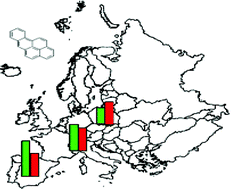Multimedia environmental fate models are commonly-applied tools for assessing the fate and distribution of contaminants in the environment. Owing to the large number of chemicals in use and the paucity of monitoring data, such models are often adopted as part of decision-support systems for chemical risk assessment. The purpose of this study was to evaluate the performance of three multimedia environmental fate models (spatially- and non-spatially-explicit) at a European scale. The assessment was conducted for four polycyclic aromatic hydrocarbons (PAHs) and hexachlorobenzene (HCB) and compared predicted and median observed concentrations using monitoring data collected for air, water, sediments and soils. Model performance in the air compartment was reasonable for all models included in the evaluation exercise as predicted concentrations were typically within a factor of 3 of the median observed concentrations. Furthermore, there was good correspondence between predictions and observations in regions that had elevated median observed concentrations for both spatially-explicit models. On the other hand, all three models consistently underestimated median observed concentrations in sediment and soil by 1–3 orders of magnitude. Although regions with elevated median observed concentrations in these environmental media were broadly identified by the spatially-explicit models, the magnitude of the discrepancy between predicted and median observed concentrations is of concern in the context of chemical risk assessment. These results were discussed in terms of factors influencing model performance such as the steady-state assumption, inaccuracies in emission estimates and the representativeness of monitoring data.

You have access to this article
 Please wait while we load your content...
Something went wrong. Try again?
Please wait while we load your content...
Something went wrong. Try again?


 Please wait while we load your content...
Please wait while we load your content...